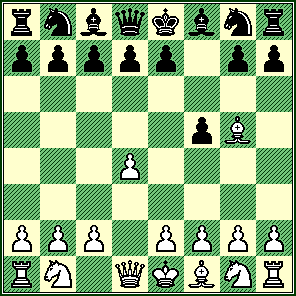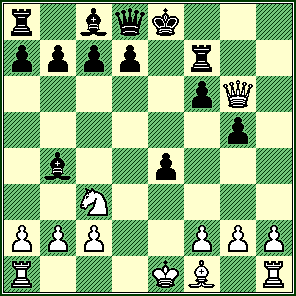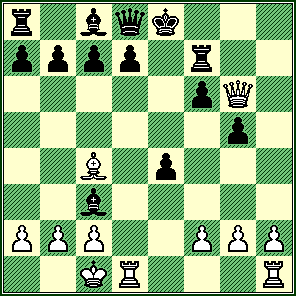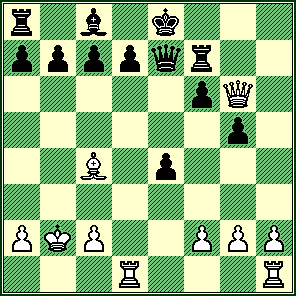GM D. Gormally (2513) - IM S. Williams (2473)
|
|
|
[A.J. Goldsby I]
An incredible game ... one that several people e-mailed me and requested that I look at.
1.d4 f5;
2.Bg5!?,
A provocative and strange opening line, the Bishop moves to attack the ghost of a Knight ...
one that has not even moved yet!
|
|
rnbqkbnr/ppppp1pp/8/5pB1/3P4/8/PPP1PPPP/RN1QKBNR b
One of the earliest known examples, and one that I have personally studied, occurred in a match game between E. Schiffers and M. Chigorin in a match in St. Petersburg, (RUS); that was played in 1878.
[ Normal here is: (>/=) 2.Nf3, "+/=" with good play for White. {See any good reference work.}
The normal plan for White usually involves a fianchetto of the KB, a line that was pioneered
by none other than the great A. Rubinstein.
[See MCO-14, (pg. # 487); for more details.] ]
2...h6!?;
(Possibly - '?!')
Black plays an equally wild response to White's 2nd move. (I deeply distrust this move, the weakness of the f7-h5 diagonal is well-known, and many opening traps use this particular motif.)
[ Maybe better was: (>/=) 2...g6; [See MCO-14, page # 489; column # 21 and all notes.] ]
3.Bh4 g5!?;
4.e4!?, (Maybe - '!')
Based on the Morphy Principle, White must open as many lines as possible here.
[ A few GM's have played this line, for example:
4.e3
Nf6; 5.Bg3 d6; 6.h4 Rg8; 7.hxg5
hxg5; 8.Nc3 e6; 9.f3 Qe7;
10.Qd2
Nc6; 11.0-0-0 Bd7; 12.e4 fxe4; 13.fxe4
0-0-0; 14.d5, "+/="
{Drawn in 48 moves.}
GM Garry Kasparov
(2775) - GM Miguel Illescas.Cordoba
(2635);
Super-GM Tournament /
Dos Hermanas, ESP; (R#4) /
05,1996.
[ See also MCO-14. Page # 489, column # 22; and all relevant notes. ] ]
4...Rh7;
Black must defend.
(He prepares to block the check from the Queen by playing his Rook from h7 to f7.)
[ Of course not: </= 4...gxh4??; 5.Qh5#. ]
5.Qh5+ Rf7;
6.Nf3 Nf6;
Black needs to defend, (& develop).
[ But of course not: </= 6...fxe4??; 7.Ne5, ("+/-") & mate next. ]
7.Qg6 Nc6;
Black must stop Ne5.
8.Bxg5!?,
Now White begins to mix things up ... at this point, he really has no choice.
[ Another continuation would be:
8.exf5 gxh4; 9.Ne5 Nxe5;
10.dxe5 Nd5; 11.e6 dxe6; 12.fxe6 Bxe6!;
13.Qxe6 Rf6, "=/+"
when Black looks OK. ]
Now comes a series of moves that is mostly forced.
8...fxe4;
9.Ne5 Nxe5;
10.dxe5 hxg5; 11.exf6 exf6?!;
Black needs to CLOSE lines, not open them!
[ Much better was:
>/= 11...e6; ('!')
{This move is practically forced,
('[]') the key a2-g8 diagonal is closed off to White's
Bishop.}
12.Be2!?
Qxf6; 13.Bh5 Qxf2+; 14.Kd1 d5; 15.Qxg5
e3; "~" (unclear)
when Black has
good play and fair "comp" for the exchange. ]
White's next move is correct because it brings a new piece into the fray - and also prepares Q-side castling.
(The White QR comes strongly to the d-file.)
12.Nc3,
('!') 12...Bb4?;
After this move, Black is lost and his position is beyond any saving.
|
|
r1bqk3/pppp1r2/5pQ1/6p1/1b2p3/2N5/PPP2PPP/R3KB1R w
Now White plays a move that both gets his King to safety and brings a Rook to the central file ...
[ Better (for Black) than the game, was:
>/= 12...d5[]; 13.0-0-0
c6; 14.Nxe4,
"+/="
with an advantage
for White. (White might have a dangerous initiative in this line,
but there is no clear, forced win. This means that this is still an improvement over
the actual course of the game.)
]
13.0-0-0!,
White ignores Black's "threat" to double his Pawns ...
[ </= 13.Bc4 Bxc3+; 14.bxc3 d5; "~" ]
13...Bxc3;
14.Bc4!,
Perhaps Black missed this nice "in-between" move?
|
|
r1bqk3/pppp1r2/5pQ1/6p1/2B1p3/2b5/PPP2PPP/2KR3R b
This position is worth a second look here.
[ Not
recommended would be:
</= 14.bxc3 d5;
"~" when White might have an edge,
but it is not nearly as effective as the continuation that was played in the actual game.
]
Now Qe7 is probably the most obdurate defense, of course if Black saves his Bishop on c3, (say 14...Be5??); then the simple QxR/f7# is the refutation.
14...Bxb2+!?;
15.Kxb2 Qe7;
Now it seems that Black has almost managed to defend.
|
|
r1b1k3/ppppqr2/5pQ1/6p1/2B1p3/8/PKP2PPP/3R3R w
Study this position carefully.
** ** ** ** ** ** ** ** ** ** ** ** ** ** ** ** ** ** ** ** ** ** ** ** ** ** ** ** ** ** ** ** ** ** ** ** ** ** ** ** ** **
Now what is White's best move?
16.h4!,
Rather than simply grab an exchange, GM Gormally opens even more lines.
(Fritz confirms that this is the best and the most forceful continuation.)
[ White could also win with: (</=) 16.Bxf7+ Qxf7; 17.Qxe4+, etc. ("+/-") {material advantage} ]
16...d5!?;
Black might have believed that he had found a defense.
(It does not matter what Black plays here, everything loses anyway.)
17.Bxd5 Qe5+;
18.c3 Be6; 19.Bxe6, "+/-"
Now Black probably realized that recapturing on e6 loses to the simple Qg8+, (winning a whole Rook for White); so it was time to throw in the towel.
---> An amusing miniature.
Copyright (c) A.J. Goldsby, 2006. All rights reserved.



